Photo by Marcela Aguero
by Patrick Ogle
ArtCenter helped change that, although the folks there are loath to take credit for being at the forefront.
“We have become an institution. People look forward to and look at art here. When they think of contemporary art and South Beach they think of us,” says Jacquenette Arnette, Director of Exhibitions for ArtCenter. “We introduced the idea of residency programs to people who might not have known about residency.”
The Residencies are an aspect of ArtCenter that set it apart from other, similar, arts organizations.
Applications for residencies, artists are “juried in” to these residencies, happen twice a year. Artists are accepted for a three year period. They can remain for two additional three year residencies; in these cases they have to be invited back are senior artists. Some residencies are completely funded. There are also 3-6 month residencies.
“The main thing we try to get are artists who may not necessarily be commercial but are contemporary, pushing boundaries, working for themselves for awhile, out of school for awhile—not that you have to go to school” says Arnette.
But isn’t just about the art
“They have to have some sort of community involvement, people will be walking through.” she says
You really don’t want a Diego Rivera sort of guy waving a pistol at tourists or prospective buyers. This isn’t just about the artists, it is about giving people access to art and, even more important, some insight into the creative process. The artists are working on their art right there for the public to see.
Below, A Video Of The Second ArtCenter Location
“We have quite a few from South America, all over the USA, Europe.” says Arnette. “William Cordova has said that coming here and dedicating himself led to the next steps to where he needed to go.”
Other recent artists include: Justine Smith, Peter Hammer, Vicente Casan (Swiss ,getting masters at FIU).
There are benefits beyond just having a space to work for artists as well.
“The benefit, first, is the high visibility area. If there is an opportunity to sell work it happens here,” says Arnette. “Most residency programs are not so open, and this gets rid of any gallery or commission.”
ArtCenter also have an infrastructure to support the artists with public relations, to bring artists together with critics, help them get picked for shows and, these days perhaps most important, help them interact with Art Basel. The last Art Basel in 2009 was the largest art show, anywhere, ever. It is one of the most important art shows in the world and it all happens in the vicinity of ArtCenter. And the atmosphere on Miami Beach changes during Art Basel time.
“It’s geared up; there is energy around that time. It makes quality important,” says Arnette. “People are coming here to look at art. To be in the center of it is fortunate.”
One of the artists in residence at ArtCenter South Florida now is Venessa Monokian.
“Coming to the ArtCenter my work was primarily photography. I have maintained this craft but defiantly add several skills to my artistic arsenal,” says Monokian. “The ArtCenter has allowed me to become more daring with my work and branch into animation, sculpture and lately electronics. I find that with the support of the other artist and the staff I have not only artistically grown but personally blossomed as well.”
Monokian says that since she is making her work for the public having their input as she develops new work is helpful.
“It’s also not a bad thing to have a prime location during all the winter events that go on during the Basel season. I don't sell so much work that it pays my rent most of the months but that is not the real reason I came to the ArtCenter,” she says. “It has helped with my exposure and gained me opportunities to speak and share my work such as the recent interview on WLRN that won a Telly Award.”
Damian Sarno, also in residence, likewise appreciates contact with the public.
“I can say that the art center affected my work and my relation to the viewer. You are able to have constant feedback, at times a little too much,” says Sarno. “As a community of artists it has brought good friends within my field, painting could be a lonely job. It has also introduced my work to many galleries and private collections.”
Luisa Mesa, just beginning her second three year term, has similar thoughts on how ArtCenter has helped and moved her work forward. She also believes it has helped her commercially.
“Especially during the winter months Art Center receives a steady stream of visitors from all over the world, some of them art collectors. My work is in corporate collections such as Royal Caribbean Cruise Lines' Oasis of the Seas, as well as private collections in Israel, Switzerland, St. Louis, Missouri, to name a few,” says Mesa. “Not everyone is a buyer but almost everyone has something to say about the work and this is nourishing most of the time. Regarding our open-door policy and availability to the public, in the beginning of my residency it was a bit difficult to get used to. At this time, it does not make me feel uncomfortable. I just keep working and most people respect that. If they have a question they ask and if not, they politely walk in, look at the work and walk out.”
Photos by Marcela Aguero
Bringing art out into the public, essentially, is a large part of what ArtCenter is. Artists do want to sell art. Interaction is great but an artist is like a shoemaker or a dentist in that art is what they do for a living. So for any gallery or residency to be of the utmost value they have to sell some of their pieces. This is where the passerby really comes into the equation. As someone rambling by ArtCenter; when should you buy a piece of?
“The most intrinsic value of art is your understanding of it and if that artist speaks to you it is worth the money to you.” says Arnette. “When you see a piece of work that you think is amazing and you say ‘I can afford that.’ It is worth it.”
Sometimes a single piece of art seems expensive. But you are not just paying for that painting, that canvas, that sculpture or photograph.
“There is a lot of money that goes into becoming an artist: school, supplies…no one pays you back for that. It’s not like Athena coming out of Zeus’ skull. The painting isn’t the first thing they (the artist) did,” says Arnette. “You are paying for all the cumulative experience that leads up to the piece you are purchasing. People think of creating as a single thing but it takes a long, long time.”
One trap artists and galleries fall into is becoming focused on a small group of people and organizations.
“Art dealers and sometimes artists say; ‘We have collectors. These are the people we want to talk to.’ We forget about communicating with the rest of society and that is what art is, communication,” says Arnette. “It is about more than selling to an elite core. It is about connecting with regular people and interacting with them.”
That is the reason for places like the ArtCenter, to foster such communication. Part of the give and take is in the feedback the artists get but it is also in the opportunity for the general public to own art that moves them.
An Addendum
I also spoke to, or was supposed to speak to, a number of other artists currently at ArtCenter. I regret I did not get the chance but you should look at these artists work right now: Jaime Gil, Anthony Ardavin, Hugo Moro, Susan Feliciano, Tony Chimento, Lissette Schaeffler, Kathy Kissik and Julie Lusson.
Alekxey Sabido not only responded for this article and spoke of how ArtCenter has been important to him. He send an image of a recent painting inspired by 200 years of Mexican Independence and 100 years of the Mexican Revolution. It is, as he noted, very different from his other work.
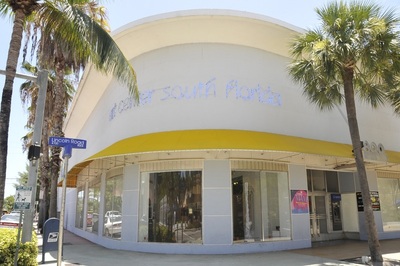
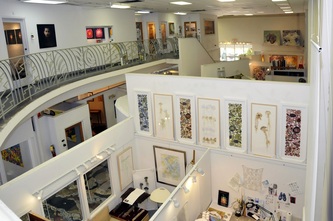
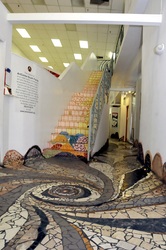
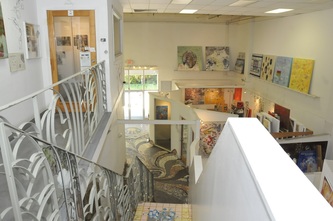
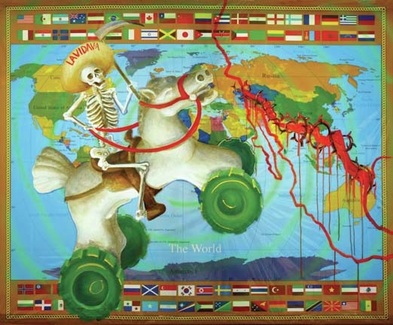
 RSS Feed
RSS Feed